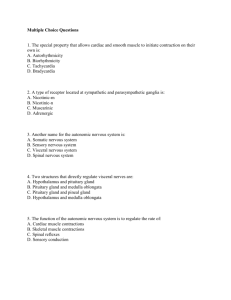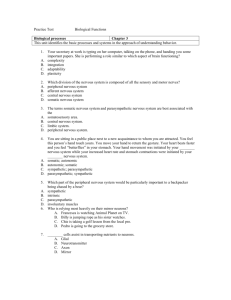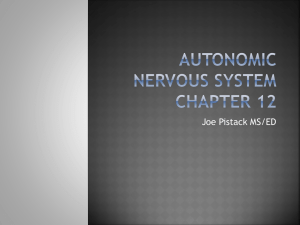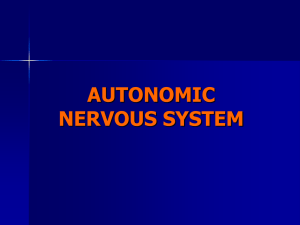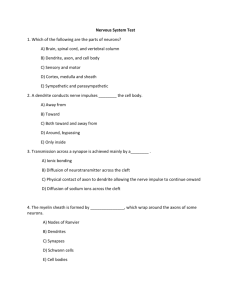Chapter 15 Notes - Las Positas College
advertisement
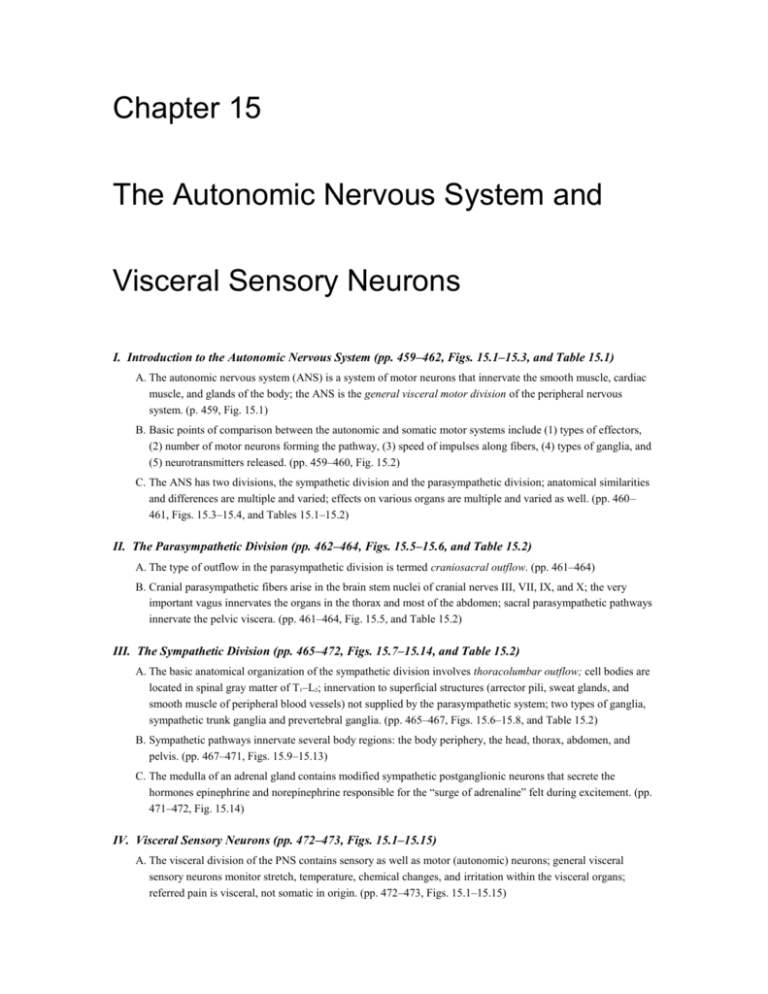
Chapter 15 The Autonomic Nervous System and Visceral Sensory Neurons I. Introduction to the Autonomic Nervous System (pp. 459–462, Figs. 15.1–15.3, and Table 15.1) A. The autonomic nervous system (ANS) is a system of motor neurons that innervate the smooth muscle, cardiac muscle, and glands of the body; the ANS is the general visceral motor division of the peripheral nervous system. (p. 459, Fig. 15.1) B. Basic points of comparison between the autonomic and somatic motor systems include (1) types of effectors, (2) number of motor neurons forming the pathway, (3) speed of impulses along fibers, (4) types of ganglia, and (5) neurotransmitters released. (pp. 459–460, Fig. 15.2) C. The ANS has two divisions, the sympathetic division and the parasympathetic division; anatomical similarities and differences are multiple and varied; effects on various organs are multiple and varied as well. (pp. 460– 461, Figs. 15.3–15.4, and Tables 15.1–15.2) II. The Parasympathetic Division (pp. 462–464, Figs. 15.5–15.6, and Table 15.2) A. The type of outflow in the parasympathetic division is termed craniosacral outflow. (pp. 461–464) B. Cranial parasympathetic fibers arise in the brain stem nuclei of cranial nerves III, VII, IX, and X; the very important vagus innervates the organs in the thorax and most of the abdomen; sacral parasympathetic pathways innervate the pelvic viscera. (pp. 461–464, Fig. 15.5, and Table 15.2) III. The Sympathetic Division (pp. 465–472, Figs. 15.7–15.14, and Table 15.2) A. The basic anatomical organization of the sympathetic division involves thoracolumbar outflow; cell bodies are located in spinal gray matter of T1–L2; innervation to superficial structures (arrector pili, sweat glands, and smooth muscle of peripheral blood vessels) not supplied by the parasympathetic system; two types of ganglia, sympathetic trunk ganglia and prevertebral ganglia. (pp. 465–467, Figs. 15.6–15.8, and Table 15.2) B. Sympathetic pathways innervate several body regions: the body periphery, the head, thorax, abdomen, and pelvis. (pp. 467–471, Figs. 15.9–15.13) C. The medulla of an adrenal gland contains modified sympathetic postganglionic neurons that secrete the hormones epinephrine and norepinephrine responsible for the “surge of adrenaline” felt during excitement. (pp. 471–472, Fig. 15.14) IV. Visceral Sensory Neurons (pp. 472–473, Figs. 15.1–15.15) A. The visceral division of the PNS contains sensory as well as motor (autonomic) neurons; general visceral sensory neurons monitor stretch, temperature, chemical changes, and irritation within the visceral organs; referred pain is visceral, not somatic in origin. (pp. 472–473, Figs. 15.1–15.15) V. Visceral Reflexes (p. 473, Fig. 15.16) A. Examples of visceral reflexes are the defecation reflex and micturition reflex. (p. 473, Fig. 15.16) B. Some visceral reflexes involve only peripheral neurons. (p. 473) VI. Central Control of the Autonomic Nervous System (pp. 473–474, Fig. 15.17) A. The CNS regulates many autonomic activities; several sources of control exist in the brain stem, spinal cord, hypothalamus, amygdala, and cerebral cortex. VII. Disorders of the Autonomic Nervous System (p. 474) A. Most autonomic disorders reflect problems with control of smooth muscle; examples of disorders of the ANS are Raynaud’s disease, hypertension, mass reflex action, achalasia, and congenital megacolon. VIII. The Autonomic Nervous System Throughout Life (pp. 474–475, Fig. 15.18) A. Preganglionic neurons develop from the neural tube; ganglionic neurons and visceral sensory neurons develop from the neural crest. Chapter 15: The Autonomic Nervous System and Visceral Sensory Neurons To the Student A study of the autonomic nervous system enables you to understand actions the body performs without conscious thought. You involuntarily experience countless smooth muscle and cardiac muscle contractions and gland secretions that provide a stable internal environment for you. Some of the important visceral functions under the regulation of the ANS are maintenance of heart rate and blood pressure, digestion, and urination. Anatomically, the ANS is described as a motor (efferent) pathway made up of two neurons, and Chapter 15 does focus on the general visceral motor functions. But, you must also realize that the general visceral sensory system constantly monitors these activities. Otherwise, how would you know you had a tummy ache? It is necessary to thoroughly review the peripheral nervous system hierarchy, as represented in Figure 15.1, to ensure a complete and factual understanding of the autonomic nervous system. Step 1: Understand the relationship of the autonomic nervous system to the body’s nervous system as a whole. - Define the autonomic nervous system (ANS). - Explain the relationship of the ANS to the PNS and the CNS. - Summarize functions of the ANS, including the influence of the general visceral senses. Step 2: Compare the autonomic nervous system to the somatic motor system. - Distinguish effectors of the ANS from the effectors of the rest of the motor (efferent) division. - Compare the number of neurons in a somatic (or branchial) motor pathway to the number of neurons in an autonomic motor pathway, including location of cell bodies. - Distinguish between preganglionic and postganglionic neurons. Step 3: Describe the autonomic nervous system. - Name the two divisions of the ANS. - Outline the basic functional differences between the sympathetic and parasympathetic divisions of the ANS. - Give examples of “fight, flight, or fright” responses experienced by your body. - Name examples of “resting and digesting” responses experienced by your body. - Describe three major anatomical differences between the sympathetic and parasympathetic divisions. - Describe major biochemical differences between the sympathetic and parasympathetic neurotransmitters. - Study textbook Table 15.1 for a summary of major anatomical and physiological differences between the sympathetic and parasympathetic divisions. Step 4: Explain the outflow of the parasympathetic division of the ANS. - Describe how the parasympathetic division relates to the brain and define cranial outflow. - Name the cranial nerves that support parasympathetic fibers. - Describe the precise locations of the preganglionic and postganglionic neurons for each of the following cranial nerves: • Outflow via the oculomotor nerve (III) • Outflow via the facial nerve (VII) • Outflow via the glossopharyngeal nerve (IX) • Outflow via the vagus nerve (X) - Explain how the parasympathetic division relates to the sacral spinal cord and describe sacral outflow. Step 5: Explain the sympathetic division of the ANS. - Describe the anatomy of the sympathetic division. - Describe why the sympathetic division is more complex than the parasympathetic division. - Distinguish between trunk ganglia and paravertebral ganglia, including examples of each. - Explain how the sympathetic division relates to the spinal cord and spinal nerves. - Describe and draw simple diagrams representing sympathetic innervation to the following body regions: • Periphery of the body • The head • Thoracic viscera • Abdominal viscera • Pelvic viscera - Explain the role of the adrenal medulla in the sympathetic division. Step 6: Understand the central nervous system control of the ANS. - Using Chapter 13, The Central Nervous System, review structures of the brain and spinal cord, as needed. - Explain the role played by the brain stem and spinal cord, including reticular formation and spinal visceral reflexes. - Explain the role played by the hypothalamus as the main integration center. - Discuss the amygdala in terms of fear-related behavior. - Explain the role of the cerebral cortex and conscious control over some autonomic functions. Step 7: Explain the relationship of visceral sensory neurons and visceral reflexes to the ANS. - Define visceral sensory neurons. - Explain the role played by visceral sensory neurons, including examples of visceral information provided. Refer to Figure 15.1. - Describe the concept of referred pain. - Explain how spinal and peripheral reflexes regulate some functions of visceral organs. Step 8: Understand the ANS throughout life. - Distinguish between the embryonic origin of postganglionic neurons and the embryonic origin of postganglionic neurons. - List examples of age-related problems that are associated with the declining efficiency of the ANS. - Briefly describe some disorders of the ANS, such as Raynaud’s disease and hypertension.


